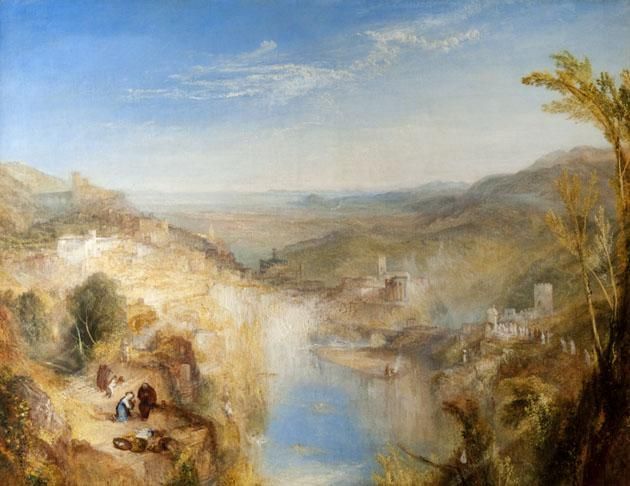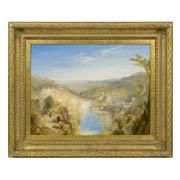

Modern Italy - the Pifferari
This oil on canvas masterpiece by J. M. W. Turner (1775-1851) dates from 1838. It is an outstanding example of Turner's mastery in painting light. The colour is intense and the surface shimmers under the searing strength of the sun, with forms representing the landscape and buildings consumed by its glare. It depicts an idyllic landscape in Italy, with a river flowing between hills and under a bridge out towards a level plain and distant sea.
Turner travelled extensively in his country and abroad to find engaging motifs for his landscapes and was particularly inspired by Italy, its classical past and its Roman Catholic ceremonies. His approach to landscape painting was essentially a romantic, idealized one and his work was often criticized as having an unfinished quality. Constable, his artistic rival, described it as 'airy visions, painted with tinted steam'.
Although the subject of Modern Italy - The Pifferari may appear to be light - the brilliance of which dissolves the view of Tivoli and the Roman Campagna - Turner was inspired by the great seventeenth-century landscape painter, Claude Lorrain. Appealing to contemporary taste, Turner records 'picturesque' Catholic practices such as woman confessing to a monk (left foreground) and a procession with banners and crucifix, wending its way towards a church (lower right). However, the most intriguing element in the scene is the group (lower left), the pifferari or strolling musicians who, armed with bagpipes and pifferi (a sort of oboe), came to Rome each Christmas from southern Italy to play at wayside shrines and street-corner images of the Madonna in the belief that their music relieved her labour pains. Virtually all contemporary travel writers who visited Rome at Christmas remarked upon this unusual custom and the subject was depicted by other artists including the Scottish artist Sir David Wilkie.
Allegedly the custom has its roots in a pagan tradition connected with Ovid, who encouraged the worship of the gods with music, and it was probably this association with the Roman poet Ovid that prompted Turner to paint a companion piece, Ancient Italy - Ovid banished from Rome. Both paintings were shown at the Royal Academy in 1838. Together they explore the interrelation between the past and the present, set against the constant factor of the annually renewed beauty of the natural world. That the idea of birth and new life was the underlying meaning of Modern Italy has been confirmed by the discovery of an engraver's proof for the subject on which Turner requested that a bird's nest with eggs and a child wrapped in swaddling clothes be added in the foreground.
Both paintings were first owned by a Scotsman, H. A. J. Munro of Novar, a personal friend and principal patron of Turner. However, they did not stay together, our picture passing through several collections after the 1867 Munro sale until it was presented to the museum by the sons of its last owner, another Scot, James Reid of Auchterarder in 1896.
Credit: Gifted by the sons of James Reid of Auchterarder, 1896
1838
Oil on canvas
926.0 x 1232.0 mm
733
Images and text: CSG CIC Glasgow Museums Collection, 2025










